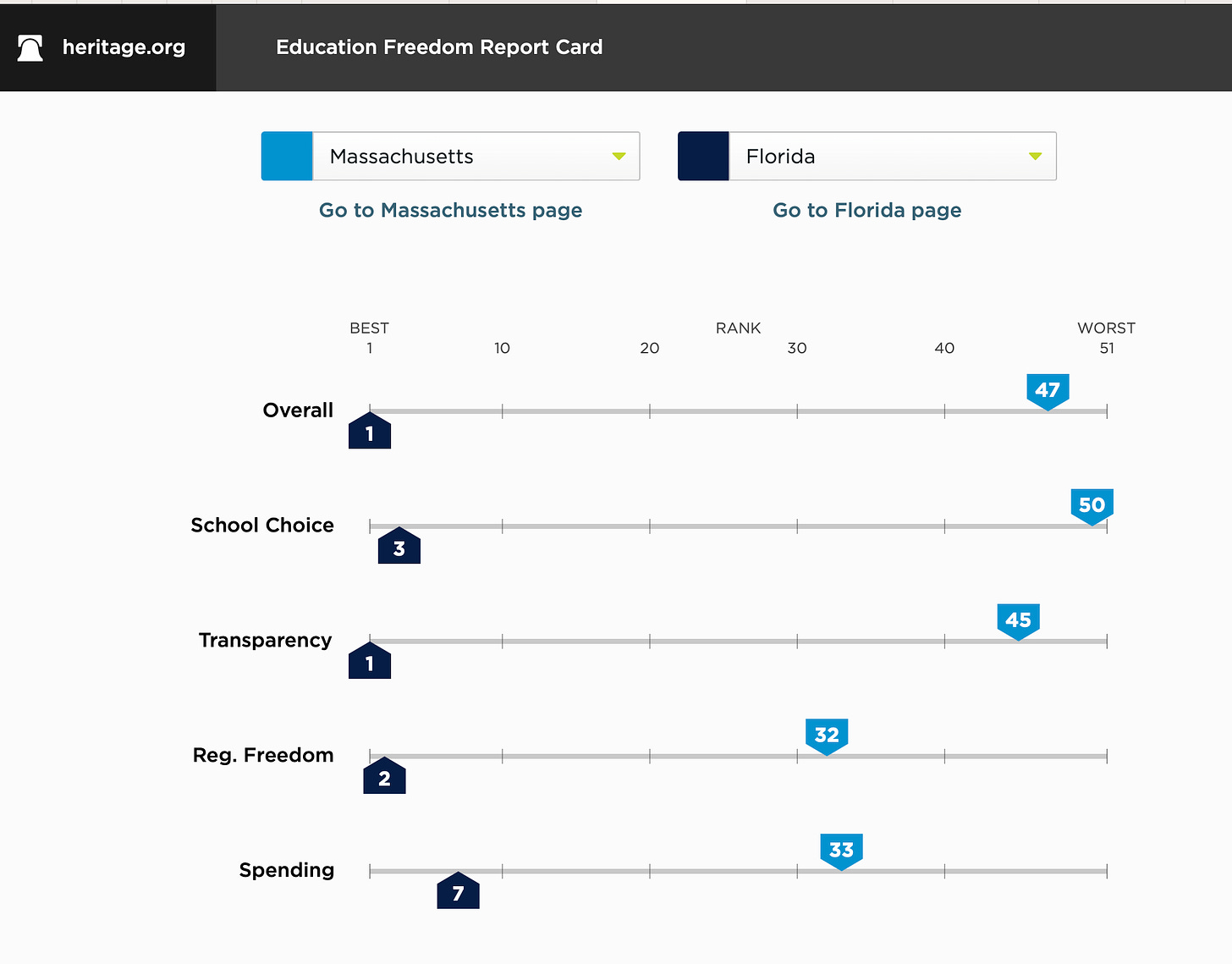If this is freedom, I don't want it
Conservative cranks continue to sell "educational freedom" as a mono-partisan, mono-racial, white nationalist ideal. It will fail.
When I think of educational freedom, my mind goes to many places.
But, unfortunately, Florida isn’t one of them.
But, according to a school choice index created by the Heritage Foundation, a once powerful conservative think-tank-turned-MAGA research mill, the Sunshine State is tops when it comes to being educationally free.
Crazy, right? I couldn’t see that coming - said no one.
Across the political spectrum, ideas about what constitutes “freedom” in education abound - sometimes converging and other times departing.
On the right, I like the libertarian ideal of helping young people find the best schooling options with their parents and guardians.
Such as this framing from Cato Institute:
In an ideal world, every child would have access to the education that’s right for them. All parents could choose from diverse, high-quality options regardless of their means. Parents and educators would harmoniously spend their time and energy providing the best possible education. Educators would be responsive to parents and employ sound pedagogical practices. Over time, innovations would expand diversity and improve the quality of the educational options available. As a result, our education system would produce literate and informed citizens well prepared for adult life.
On the left, I appreciate Peter Gray’s work on the importance of unstructured play time and learner-centered education.
In Black education, I love the intergenerational classrooms I saw while visiting Ile Omede, an African-centered private school in Oakland where younger students lead older ones in culturally-relevant math lessons.
In the ed reform world, I think about Purdue Polytechnic High School in Indianapolis, where I saw college-bound students learning to be self-directed, agile, articulate, and problem-solving.
Or Avalon Charter School in St. Paul or Magic City Acceptance Academy in Birmingham, where the schools intentionally create safe, affirming, and caring learning environments for students who might be bullied out of other schools.
At the higher education level, I think about my work at Goddard College, nestled in the sticks of Vermont, where students flex their agency by constructing their areas of study and taking ownership of their learning.
Educational freedom means we can determine how we’ll be educated and have the opportunities and resources to exercise that freedom.
This is why Florida is a preposterous entrant into the education freedom fold.
Heritage’s Education Freedom Report Card defines educational freedom with four criteria: “school choice, transparency, regulatory freedom, and spending.”
With those broad categories driving their ratings, they say this about Florida:
“Families looking for a state that embraces education freedom respects parents’ rights, and provides a decent ROI for taxpayers should look no further than The Sunshine State.”
And this is where one man’s freedom is another man’s prison.
Heritage’s dream state is leading the nation in regulations that curtail free speech, academic freedom, and diversity of thought. The education gag orders are so profound in Florida that a court deemed its “STOP WOKE Act” to be “positively dystopian.”
Sure, Florida may offer parents one of the broadest arrays of types of schools, but what good is the freedom to choose a school where you have no freedom to choose what you’ll learn in those schools?
What if I’m a parent who wants my kids to take the AP African American Studies course, complete with lessons about intersectionality and the Black Lives Matter Movement?
In that case, Florida would have to be at the bottom of my freedom index.
When you look at the top states on the Heritage list, two things become clear - 1) their top states crosstab with those that have passed educational gag orders and rebranded Civil Rights, diversity, and inclusion efforts as anti-white “divisive” concepts and 2) these states are academic laggards.
The list prioritizes states that fund options outside public schools and deprioritizes student outcomes and Civil Rights.
See for yourself:
For example, think about this match-up between two states, red Florida and blue Massachusetts (a clear education leader year over year).
For Heritage, the state with the best academic outcomes (MA) loses badly to the state (FL) that - according to a Standford study on educational opportunity - had the worst learning rate relative to the national average.
So, I suppose Heritage’s vision of “freedom” is the ability to choose schools but not choose curricula.
My vision of educational freedom requires that families have various options that respect America’s world-famous cultural, religious, ethnic, and geographic diversity.







Thanks, Chris, great points